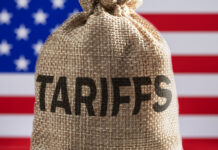Markets
Friday’s nasty market sell-off dragged into yesterday’s Asian and European trading as traders hit the panic button in the run-up to tomorrow’s tariff announcement by US president Trump. It’s planned as a Rose Garden event at the White House at 3 pm Washington time (9pm CET), but we wouldn’t be surprised to see headlines arriving earlier via the POTUS’ social media platforms. Trump yesterday said that he settled on a plan. Whether it will be the long-flagged reciprocal tariffs or a final U-turn towards a 20% global tariff thus remains unclear. Yesterday’s sell-off gradually slowed as US dealings got under way with even some rebound action into the close. The tech-heavy Nasdaq index was 2.7% weaker at its worst intraday moment, to eventually close the session virtually unchanged compared with Friday’s closing levels. The S&P 500 (+0.55%) and Dow Jones (+1%) even ended with gains. European equity futures this morning also suggest a somewhat firmer start after suffering 1%+ losses for the third time in four trading sessions yesterday. US Treasuries faded somewhat into the close, but the return action was less outspoken than in equities. Daily changes on the US yield curve varied between -2.8 bps and -5.7 bps with the curve bull flattening. German Bunds underperformed with curve moves between +2.7 bps (2-yr) and -1.1 bp (30-yr). The German 10-yr yield technically tested 2.65% support. The front end suffered a setback after Bloomberg published an article suggesting that more ECB officials appear ready to accept an April rate pause. EUR/USD at the same time moved back from the 1.08 area to a close near 1.0820. “Dovish officials still see the need for further loosening, but may not insist on a seventh reduction since June if their more hawkish colleagues want additional time to assess the data, the people said. They stressed, however, that the meeting is two and a half weeks away and the thinking may yet shift.” We hold firmly to our view of a final 25 bps (to 2.25%) tactical rate cut before sticking to a long pause. EMU money market rates remain to aggressive in our view, discounting sub-2% ECB policy rate by the end of the year. April EMU CPI numbers, up for release today, aren’t expected to alter that view in light of already published national figures. Consensus expect headline inflation to pick-up to 0.6% M/M with the annual reading dipping from 2.3% to 2.2%. Core inflation is set to slow from 2.6% to 2.5%. The US eco calendar contains February JOLTS job openings (7.65mn expected from 7.74mn) and the March manufacturing ISM (49.5 from 50.3). The probability is low that they’ll directionally steer markets ahead of the big event risk dubbed “Liberation Day”.
News & Views
The Reserve Bank of Australia (RBA) left its policy rate unchanged at 4.1% after an inaugural rate cut in February. At the press conference, Governor Bullock indicated that the decision was a consensus one and that the RBA didn’t explicitly discuss a rate cut. In its policy statement the central bank signaled a cautious approach. Recent information suggests that underlying inflation continues to ease, but that the board needs to be confident that inflation will return to the midpoint of the 2-3% target range on a sustainable basis. Private domestic demand is recovering, but some business continue reporting weakness. The labour market remains tight and productivity hasn’t picked up resulting in ongoing high labour costs. International uncertainty remains elevated and might impact inflation in either direction. The Bank concludes that monetary policy remains restrictive, but governor Bullock indicated that it wasn’t as restrictive as has been the case at others. In this respect, the RBA hasn’t made up its mind on a May rate cut. Even so, the market sees slightly less than 70% chance of a May rate cut. The Aussie dollar underperformed yesterday on overall risk-off, but regains slightly ground this morning (AUD/USD 0.6261).
The BoJ this morning published its quarterly Tankan business outlook. The headline large manufacturing conditions index eased to 12 from 14, but this remains a decent level. The outlook in the sector eased only modestly to 12 from 13. The large non-manufacturing index improved from 33 to 35 (outlook 28 unchanged). Big firms expect capex to increase 3.1% this FY, marginally softer than expected. Firms still also expect inflation to rise to 2.5% in the year ahead and still to stay at 2.3% in five years (both higher compared to previous report). This suggests that inflation expectations are anchored near the BOJ target and should support a further normalization of monetary policy. USD/JPY trades little changed near 150 this morning.













